How did literary historian, Edward Brereton Goodacre, become an intelligence officer and interrogator of spies with MI5? That’s what I want to know. Although I doubt that I will ever learn the answer. I wrote about Goodacre several years ago but I thought I might try to expand on what we know about this enigmatic man.
Introduction
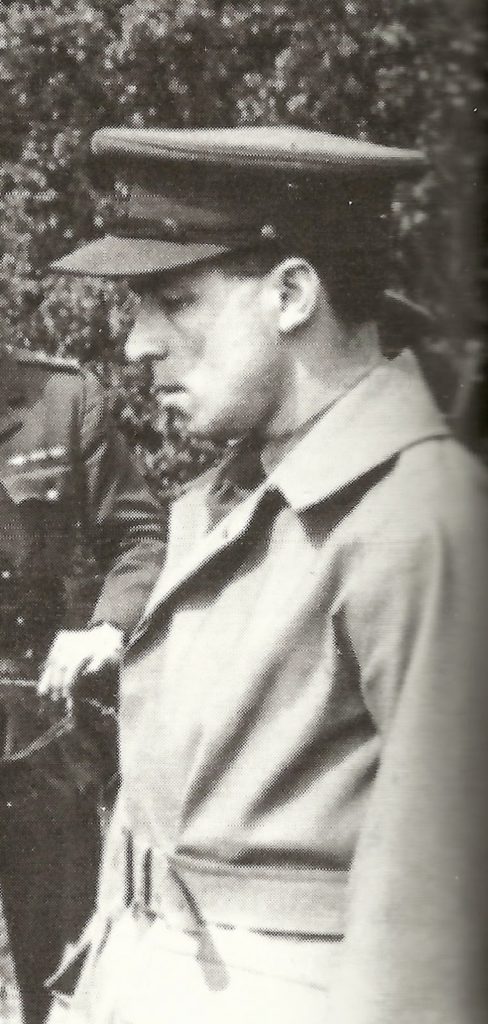
(from Karel Richter’s Security Service files – Nat. Arch.)
Goodacre was recruited as an intelligence officer with MI5 and served as an interrogator at MI5’s secret wartime interrogation centre, Camp 020, located at Latchmere House in Ham Common. I wrote a series of blogs delving into each off the interrogator’s who dealt with Josef Jakobs but Goodacre was a bit of a conundrum.
Goodacre apparently studied at Oxford and received a Bachelor of Arts, probably in the early 1920s. Beyond that, he disappears from view for almost two decades, popping up again in 1941 when he was commissioned as an officer in the Intelligence Corps.
I’ve done a bit more digging, trying to piece together his life for little snippets and fragments. We know that he joined the Historic Society of Lancashire and Cheshire as a member in 1933, his election proposed by F.H. Cheetham, a fairly prolific author of articles on the history of Lancashire.
Five years later, on 24 November 1938, Goodacre was elected as a life-member of the Society, so he was obviously a fairly well-respected historian. Even while living and working in Geneva at the United Nations after the war, Goodacre submitted pieces to the Society for publication in their Transactions journal.
In 1959, for example, Goodacre had submitted a short piece entitled “Robert Chester, The Poet”. It was published in the Transactions of the Society in 1960:
ROBERT CHESTER, THE POET
Among the Clifton Papers in the Lancashire Record Office at Preston is a letter of attorney (DD CL 915) dated 18 January 1603/4 from Sir John Salusburie of Lleweny in the county of Denbigh, knight, to Gryffith Price, gentleman, and John Heaton, servant to Sir John Salusburie, to receive of Sir Richard Molyneux of Sephton, knight, the sum of 1,000 marks at the feast of the Purification next ensuing.
This document is interesting for two reasons: first, because it ties up with No. 88 in the Calendar of Salisbury Correspondence, published by the University of Wales Press, a letter which the editor has been unable to date satisfactorily, and secondly, because the payment is witnessed on the back of the document by “Ed. Theloal, Edwarde Salusburye, Will. Lloyd, Ro. Thelwall, Robt. Pierce” and “Robert Chester”.
Some months ago I forwarded a photostat of these signatures to Dr. Hiscock, the deputy librarian of Christ Church, Oxford, who kindly compared them with those in Ch.Ch. MS 184, and stated in his reply: “I consider that the Chester signatures in our MS 184 are the same as shown on your photostat”. This confirmation is important because it narrows down the problem of the identity of Robert Chester the author of “Love’s Martyr”, the collection of poems, published in 1601, to which is appended among others, the poem The Phoenix and Turtle, attributed to William Shakespeare. It is now clear that Robert Chester the poet must have lived somewhere in the neighbourhood of Denbigh, at any rate between Denbigh and Liverpool, possibly even in Chester itself. Perhaps a careful search of local parish registers and similar records for the years round 1600 would help to solve the problem once and for all.
E. B. GOODACRE
Judging from earlier publications, establishing the identity of Robert Chester had preoccupied and perplexed many literary historians. And ,despite Goodacre’s suggestion, the identity of Robert Chester is still a mystery to this day.
But let’s go back to the beginning of Goodacre’s historical journey. I found a couple of publications which flesh out his schooling a bit more, thanks to his skill in cricket.
Royal Masonic School for Boys
In my deep searches via Google, I came across a 1919 publication in the St. Albans School Digital Archives which has a section on cricket matches. According to the publication, on 16 July, 1919, St. Albans played the boys from the Royal Masonic School. The match was played on St. Alban’s Ground and the School won by two runs. In a list of players and their scores, we find this under the Royal Masonic School:
E.B. Goodacre, run out … … 5
I’m going to take this to mean that Goodacre scored 5 runs but was run out. Not a great showing for Goodacre as some players scored 39, 25 and 26 runs.
It would appear that both St. Albans (Hertfordshire) and Royal Masonic School (Bushey) were boarding schools for boys. I did a bit of research on the Royal Masonic School for Boys (there is one for Girls as well) but was stymied by the fact that it closed in 1977 after declining enrolment. The old school building, located in Bushey, near Watford north of London, has been redeveloped as luxury flats. While the school might be closed, The Old Masonians (former pupils of the school) have a website for former alumni but much of the site is only accessible via password.
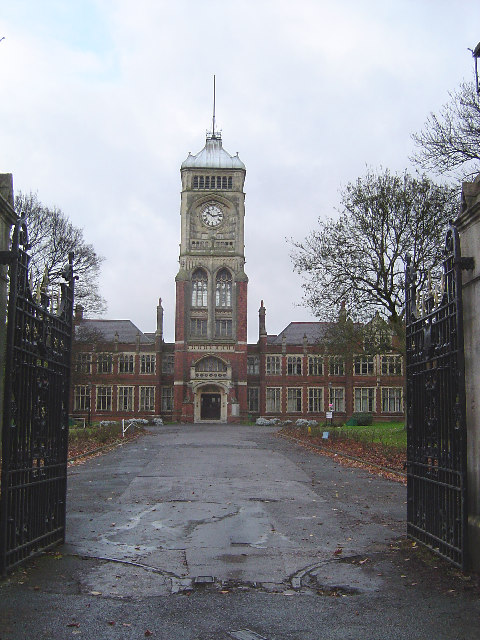
(From Wikipedia)
Goodacre’s presence at the school in 1919 does, however, give us a timeline for his schooling. He would have been 17 years old (just a month or so shy of his 18th birthday) at the time of the cricket match, just about ready to head off to university. The fact that he was attending the Royal Masonic School did leave me wondering if he, or his father, was affiliated with the Masons. I did find a membership list for the United Grand Lodge of England (Freemasons) which noted that Edward Ernest Goodacre (the father) joined the lodge in 1900, although it appears that he did not pay his dues after that year.
St. John’s College, Oxford
Goodacre’s cricket activity also helped track down a lead for his time at Oxford. I came across a publication, The St. Edward’s School Chronicle, from Oxford. The July 1920 edition (10 pages long) had a very simple reference to Goodacre under its section on Cricket. I’m not an expert on cricket but I think I’ve worked out the general gist of the Goodacre reference.
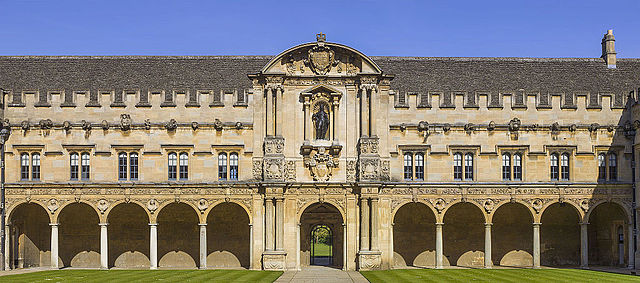
According to the article, St. Edward’s School (SES) played against St. John’s College on 2 June, 1920. Played on St. John’s ground, the game did not start well for SES as they lost four good wickets for 17 runs. But then a lad named Thorman “began scoring freely all round the wicket, picking out the right ones and timing them beautifully”. The article goes on to note that:
“The School [SES] fielding was good but the picking up not so clean as it should have been on such a ground. Boots inadequately spiked may fairly account for that. It appeared as though St. John’s might be all out before time arrived but the School failed to separate the next pair, who carried the score to 138 when time came and just saved the school from being beaten.”
Which leaves me wondering… did SES win or lose? The first line of the article noted that the game was played “on St. John’s Ground, June 2nd. Drawn.” So it was tied? Or did they draw for the ground on which they would play? The final score appears to have been SES 146 and St. John’s College 138. So perhaps SES won?
As for Goodacre, there are two references to him in the Scores section. At first, I thought he was playing for SES but a bit of research would suggest that he actually played for St. John’s:
S.E.S.
Mortimer, b Graves 4
…
C.M. Thorman, c and b Berthoud 76
Cox, b Macmillan 3
B.E. Moody, c Macmillan, b Berthoud 76
J.W.M. Fletcher, run out 7
Pollard, not out 18
Harding-Newman, F.W., b Goodacre 4
Then comes the scoring for St. John’s which simply notes at the bottom:
“L.A. Impey, A.M.P. Wilson and E.B. Goodacre did not bat.”
From this, I deduce that Goodacre was bowling to Harding-Newman which would mean he was on the St. John’s team. Just to be on the safe side, I had a look through the St. Edward’s School Chronicle digital archives and… there is no further mention of Goodacre. This little snippet does, however, set us further along his trail and confirms that he likely graduated from the Royal Masonic School for Boys in 1919/1920 and began his studies at Oxford in 1919/1920. What he studied at Oxford is still, however, a mystery.
A Linguist
I did come across a tiny notice in The Times of 27 March 1922 which confirms that he studied at St. John’s and gives us another snippet of information:
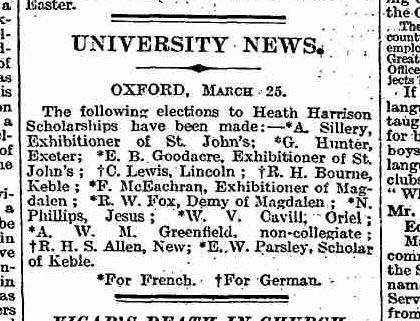
University News
Oxford – March 25
The following elections to Heath Harrison Scholarships have been made:
… *E.B. Goodacre, Exhibitioner of St. John’s;
(*For French)
Ah-hah, now we get closer to the heart of Goodacre’s recruitment into the Intelligence Corps, he may have had a gift for languages, a valuable skill for interrogators of foreign spies. From what I can gather, the Heath Harrison Scholarship today is a travelling scholarship which makes me wonder if the same was true back in Goodacre’s day. Perhaps he travelled to France to study French? These are tantalizing tidbits and it’s unfortunate that St. John’s College does not have a digital archives of old college newsletters and journals. Perhaps they will move into the 21st century in a year or two. In the meantime, we know virtually nothing about what Goodacre did between 1922 and 1933.
1930s Literary Work
The next time we pick up Goodacre’s trail is in 1933 when he was elected a member of the Historic Society of Lancashire and Cheshire. At first, I thought this might meant that he had studied history but, several publications lead me to believe that he might have been a literary historian.
Hamlet Duel
In 1934, The Times Literary Supplement published an exchange of letters about the details of the duel in Shakespeare’s Hamlet (between Romeo and Laertes). In January and February, 1934, Goodacre submitted two pieces to newspaper in response to a piece written by Professor Dover Wilson’s interpretation of the fencing scene in Hamlet. I had no idea that there could be that much discussion about a scene from a play but… apparently there are more things unknown than known! Goodacre’s letters are still quoted today and are apparently of great interest to stage directors, fight directors and dramaturgs (a literary advisor to theatre, opera, etc). Fascinating.
A History of the Old Parish of Bidston, Cheshire
Goodacre is also mentioned in a footnote of A History of the Old Parish of Bidston, Cheshire. This article was published in volume 87 of the Historic Society of Lancashire and Cheshire in 1935. The history had been compiled for Mr. E.B. Royden by John Brownbill. Unfortunately, Brownbill passed away in May 1931 before the manuscript could be revised and published. Royden submitted the manuscript to the society for publication. A footnote regarding a dispute from the 1600s notes that:
“Mr. E.B. Goodacre of Beach House, Orrell Mount, Wigan, communicated the above to Mr. Royden after Mr. Brownbill’s death.”
The footnote provides us with another clue, this one sheds some light on where Goodacre was living at the time and we will come back to that in due course.
In 1939, Goodacre wrote a piece for the Society’s journal expanding on some of the information from Brownbill’s manuscript. The article, entitled Three Notes on Bidston and the Stanleys, refers to some documents that Goodacre has accessed at the Public Record Office and which he used to expand on some of Brownbill’s information and conclusions.
Bancks Family
Goodacre would appear to have been somewhat of an expert on local Lancashire history. In June 1937, he wrote several letters to Ernest Bosdin Leech (1875-1950) in Manchester. The letters are part of Leech’s files which are now held by the Manchester Medical Collection. Leech was a local physician who, in his spare time, made a hobby of genealogy and local medical history. Goodacre apparently wrote to Leech regarding John and Clement Bancks. From what I can gather, John Bancks was a physician in Manchester who passed away in 1842. There was also a prominent Bancks family in the Wigan area, and it is possible that Goodacre wrote to Leech concerning the possible connection between the two families.
John Donne
In 1940, a year after the onset of war, another article authored by Goodacre appeared in the Historic Society of Lancashire and Cheshire (Volume 92), entitled: Henry, earl of Derby’s suite on his embassy to Parish in 1584-5. The title of the article says it all, Goodacre presented information on the membership of individuals who formed part of Henry’s suite or retinue. One of the names on the list is a “Mr. John Donnes” which some scholars have considered identical with the famous Catholic “John Donne” who later became a cleric with the Church of England. The Earl of Derby’s trip to France would have been around the same time that Queen Elizabeth I was cracking down on English Catholics. The article is notable too in that it gives Goodacre’s degree as “B.A.”, in case we were in any doubt as to his field of studies at St. John’s College.
Miscellaneous Publications
In the same issue of the historic society as the Early of Derby suite, Goodacre also received a nod from the Rev. W.W. Longford (M.A., D.D., F.S.A.) who wrote a piece entitled An Accusation of Witchcraft, 1582. The article features the text of a “Bill of Complaint” to the “Star Chamber”, the details of which need not concern us. In his introduction, Longford noted that:
The subjoined Bill of Complaint, with a portion of a deposition, was found at the Public Record Office by Mr. E.B. Goodacre, of Orrell Mount, and kindly sent by him as a pendant to the paper on the Osbaldston family (Vol. 87). [This was another piece published by Longford in 1935 entitled Some notes on the family of Osbaldston.]
I found a mention of Goodacre in the Index to Johnsonian Gleanings. Alas, the Gleanings are not available online, but Goodacre apparently appears in volume 10, page 182.
Finally, Goodacre also wrote a manuscript (unpublished) entitled The Prescott’s of Ayrfield which, at one point, was housed at the Wigan Public Library but the present whereabouts of the document are currently unknown. Ayrfield was near Upholland which is near Orrell Mount and Wigan. Now would seem to be a good time to focus on Goodacre’s abode during mid to late 1930s.
Beech House, Orrell Mount, Wigan
As noted above, Goodacre’s address at various times during this period (1936, 1940) was given as Beech House, Orrell Mount, Wigan. While Orrell is relatively easy to find on maps, Orrell Mount is a bit more of a struggle. According to the Parks & Gardens site:
Orrell Mount is an 18th-century house with grounds and a park to the east of Orrell Post. Orrell Cottage lies to the east, with open fields to the north. There is possibly evidence of subdivision of the site on the western boundary along the line of the road for houses. There is a small pond to the rear of the house with a turret at the eastern edge of the pleasure ground. The park lies to the north. The former field boundaries are still clear. There has been some thickening of the planting along the northern boundary of the park.
It is not clear from Google maps where exactly this 18th century house might be standing, particularly as the area has seen quite a bit of development. I have been able to find no trace of Beech House (or Beach House in some spellings). What we do know is that in 1936, Goodacre was living at that address with two other individuals:
Goodacre, Edward Brereton, Beach House, Orrell Mount
Goodacre, Elizabeth Helena (Mrs.), Beach House, Orrell Mount
Goodacre, Marjorie Helen (Miss), Beach House, Orrell Mount
Elizabeth Helena was Goodacre’s mother and Marjorie Helen was his sister. While Goodacre had been born in Rochdale, northeast of Manchester in 1901, by the time Marjorie was born seven years later, the family had moved to Atherton (just northwest of Manchester). While the father passed away in 1909 in Southport (on the Lancashire coast), by 1914 to 1916, mother Elizabeth Helena had moved the family to Orrell Mount just west of Wigan. She herself had been born in Upholland, which is just west of Orrell, so perhaps she wanted to be closer to her own extended family. Her father, Thomas Edward Marsh was still alive in 1911, living on a farm with several of his children. One, Herbert Marsh, was married and still living in Upholland in 1939.
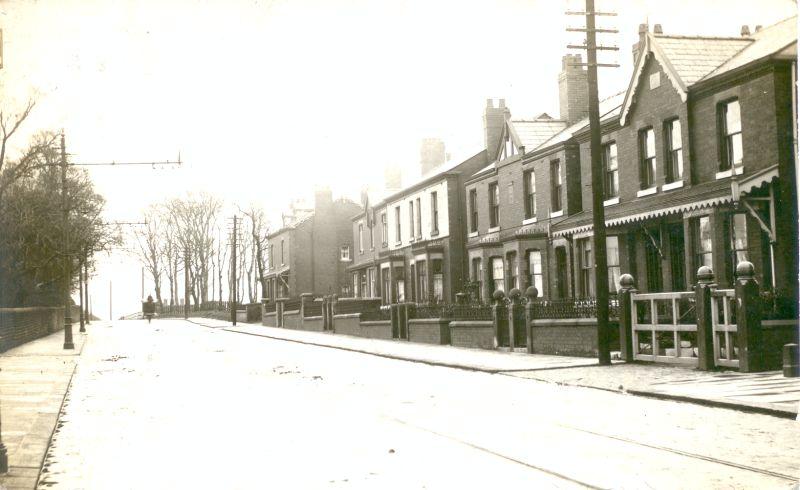
(From Wigan World Photo Album site)
In the 1939 National Registration, Elizabeth and Marjorie are living at 187 Orrell Mount, which I would presume to be the same as Beech House. Whether that is the same as Orrell Road is another question. There is no 187 Orrell Road and its probable location (based on neighbouring house numbers) has now being taken up by the M6 motorway. That location would have been just across the street from The Mount, a pub and hotel located in an old building on the north side of Orrell Road. Perhaps that building is the former 18th century building referred to in the Parks and Gardens site above?
I found a WiganWorld forum discussion which suggested that the 18th century house was The Mount (now a pub). Some writers thought that it might have been a nunnery, but apparently the former nunnery composed of two buildings just west of The Mount. Although… the Wigan & Leigh Buildings site notes that the nuns lived in what is now The Mount and ran the “nunnery” buildings as a school. Unclear as to which site is accurate! The Historic England site (heritage buildings) notes The Mount and Nunnery were both built in the early 19th century sooo… we’re no clearer on discovering if either of these buildings is the same as the 18th century house on the Parks and Garden site.
On the other hand, the WiganWorld site did note that many of the houses along that stretch of road had been built by mine owners and that about a dozen houses were demolished to make way for the M6. I am going to guess that Beech House was one of those demolished houses.
Elizabeth would have been 62 in 1939 and Marjorie would have been 31 years old. While Elizabeth’s occupation was “unpaid domestic duties”, Marjorie was “Civil Servant, shorthand typist, Board of Inland Revenue”. She was also a part time ambulance driver for the Orrell V.D.C. (Volunteer Defence Corps?) – possibly U.D.C. (no idea).
It is interesting to note that Goodacre does not appear in the 1939 National Registration. Perhaps he had already joined the army and was later transferred to the Intelligence Corps when his gift for languages was discovered.
War Service
While I know that Goodacre was present at Camp 020 in 1941, and involved in the interrogations of Josef Jakobs and Karel Richter, I haven’t really tried to follow his career through the interrogation documents of other spies. But, a passenger manifest from 1943, would seem to suggest that Goodacre did not stay at Camp 020 for the duration of the war. On 7 June, Goodacre sailed from Gourock, Scotland, aboard the Queen Elizabeth, bound for New York. In the column designated for “Head-Tax”, the word “Diplomat” appears next to Goodacre’s name. Every other passenger on that page is either listed as “Diplomat” or “Exempt”. Several of the “Diplomat” passengers are Members of Parliament, Government Officials and Civil Servants. There is also a BBC official, a Netherlands Government Official and a Dutch Engineer, all listed as Diplomats.
As for Goodacre… he is listed as Edward B. Goodacre, 41 years old, single and a “Government Official”. He was born in Rochdale and his passage was paid for by the War Office in London. He had previously visited the USA in 1923. His nearest relative was his mother, Mrs. Helena Elizabeth Goodacre, 185 Orrell Mount, near Wigan, Lancashire. His final destination was Trinidad via Miami. Goodacre was 5’9” tall with a fresh complexion, black hear and grey-green eyes. I find it interesting that he was listed as a “diplomat” but perhaps that was standard procedure for government officials travelling on official business. What exactly Goodacre did in Trinidad is unknown although a letter posted in the spy display the Imperial War Museum might shed some light on the matter. I don’t have a good image of the letter, but the display caption notes that it contains “Orders sent to Captain E.B. Goodacre, an MI5 officer, instructing him to carry out security duties in Trinidad.” How long Goodacre stayed in Trinidad is, unfortunately, also unknown.
The following year, Goodacre (now a Captain in H.M. Army) and his sister Marjorie (surname Barter, having married Thomas W. Barter in 1942) were named in the probate documents for their mother who passed away on 11 March 1944. At the time of her death, Elizabeth was living at 185 Orrell Road, Orrell. The will was probated on 4 September with an estate valued at just over £7000. It is interesting to note that “Orrell Mount” (in 1939) has now become “Orrell Road”, although the 185 Orrell Road address is also no longer in existence thanks to the M6. Did Goodacre return to England for his mother’s funeral? This is likely a question that will never be answered and we lose track of Goodacre for a few years.
League of Nations
While researching my earlier blog, I had found a site at Indiana University which hosted the League of Nations Photo Archives. Unfortunately, that site now shows an error message. When I accessed the site in 2015, it displayed a list of Secretariat Officials which included Goodacre and his former Camp 020 colleague, Albert Daniel Meurig Evans. While trying to find that resource on other sites (unsuccessfully, I might add), I did come across the League of Nations search engine site hosted by the University of Heidelberg. There, they have a listing for Edward Brerston [sic] Goodacre:
Born 26/7/1901 in Rochdale, UK
Nationality – English
Roles in Organisations:
LoN Précis-Writing Department :
LoN Précis Writer (LoN First Division) (27/5/1931-27/9/1931)
LoN Précis Writer (LoN First Division) (4/7/1938-30/9/1939)
LoN Précis Writer (LoN First Division) (7/4/1946-18/4/1946)
Delegate: blank
Residences:
Rochdale: United Kingdom
United Kingdom: Europe – 1931 – Personal Assistant to Director of an association of British manufacturers
All of this is quite fascinating as it sheds a light on some aspects of Goodacre’s career which we haven’t seen before. It’s clear that he started to have a relationship with the League of Nations (precursor to the United Nations) quite early, for a few months in 1931. His skills in French likely got him the position. He also worked for them for just over a year prior to the war which might explain why he does not appear on the 1939 National Registration. Perhaps he was abroad at the time. And then a brief stint after the war for just over 10 days in 1946. I had a look at what a “Précis Writer” actually does. Essentially, they summarize various documents and must have a good skill with languages, preferably three modern languages, and a broad knowledge of current events.
I’m pretty sure that Goodacre did not continue as a précis writer after the war, but that position likely helped him get his foot in the door with the organization, and he stayed in Geneva for the next 15 years or so. Who the “Director of an association of British manufacturers” might be is still a complete mystery. Orrell had several different industries: a cotton mill where raw cotton was spun into thread and a brick and tile factory. It is possible that the “association of British manufacturers” might have had something to do with either industry and it is clear that Goodacre wasn’t just a literary historian…
Switzerland
As noted in my earlier blog, we know that Goodacre married Kathleen Margaret Ashworth (of Dukinfield, east of Manchester) on 12 May 1948 at St. Ann’s Church in Manchester. The couple had two children:
A son – born 24 February 1949 in Geneva
A daughter – born 9 March 1953 in Geneva
While the children’s names are not given there are a few possibilities based on the overseas birth indices, namely an Edward or Edward H.R. Goodacre, born 1946-1950 in Geneva and a Susan E. Goodacre, born 1951-1954 in Geneva. There is also an Elizabeth A. Goodacre born 1951-1954 in Rotterdam, Holland, although it is not clear if this might be another child of Edward and Kathleen. Edward’s son may be identical with Edward Humphrey Roger Goodacre, a tourism development consultant and director of a number of companies in the UK. This Edward H.R. Goodacre was also born in February 1949 and the similarity seems too much to be just coincidence. Edward (H.R.) Goodacre seems to go by “Roger Goodacre” and works closely with the UNWTO in developing sustainable tourism around the world, particularly for emerging markets. It would seem that the apple doesn’t fall far from the tree. Goodacre worked for the UN and his son seems to have done the same.
Whilst working for the United Nations in Geneva, Goodacre did manage to keep his connection with literary history. As noted above, he authored a piece on Robert Chester in 1960. A few years later, in 1963, he was involved in the publication of a little travel guidebook for the Countryside around Geneva. Ostensibly authored by Jacques Chenevière and it would appear that Goodacre provided the English translation. One online book seller noted that:
The guide came out in a French edition and the author of that one was Jacques Chenevière whose name is at the top, but if you look inside it states that this ENGLISH edition was written by Edward B. Goodacre. The guide measures 7-1/2″x10″ and has numerous beautiful black and white photographs plus text.

(From Garrison House Ephemera site)
Chenevière was a member of the International Committee of the Red Cross and had worked for them since 1914. Rather fascinating that Goodacre, who had worked at a secret interrogation centre which the ICRC did not even know existed, and which was not governed by the Geneva Convention, should end up working with such a staunch supporter of the ICRC. Even more fascinating when one learns that Jacques was head of the Central Prisoners of War Agency from 1939 to 1945.
It would seem likely that Goodacre retired upon reaching the age of 65 in 1966. Whether he remained in Geneva is unknown. His sister Marjorie passed away on 22 December 1967 in Norwich. Perhaps Goodacre and his wife travelled during their retirement. Although… Kathleen was a good 22 years younger than Goodacre, having been born 19 October 1923 in Dukinfield, Cheshire.
I did find a probate index for Edward Brereton Goodacre which stated that he died on 2 May 1979 and was living at 5 Seaward Avenue, Barton-on-Sea, Hampshire. The will was probated on 4 October in Winchester and Goodacre’s estate was worth just over £69,000.
As for Kathleen, she passed away in Écully, France (just outside Lyon) on 19 December 1991. She had been residing at 9 Le Joli Mai Allee Rue Tramier. Her will was probated in Winchester on 7 July 1992 with an estate valued at just over £84,000. It would appear that Le Joli Mai is a residence on the Rue August Tramier in Écully. Lyon is not all that far away from Geneva but one does wonder how Goodacre came to pass away in Barton-on-Sea, England, while Kathleen passed away in Écully, France.
Goodacre’s Parents
I went on a bit of a side trail, trying to trace Goodacre’s parents. His father, Edward Ernest Goodacre was born 1 July 1865 in Stretford, Lancashire, the son of William, a schoolmaster, and his wife, Emma Brereton (ah-hah… the Brereton surname appears). Edward Sr. studied at St. John’s College, Cambridge and graduated with a B.A. in 1887. He was ordained a deacon in 1889 in Manchester and a priest in 1890. He served in the following parishes:
1889-1890 – Curate of West Houghton, Lancs.
1890-1893 – Curate of Holy Trinity, Shaw, Lancs.
1893-1896 – Curate of Turton
1896-1899 – Curate of Upholland
1899-1900 – Curate of Stand
1900-1902 – Curate of All Saints’, Hamer
1902-1909 – Curate of Atherton
1909 – went to Jamaica
1910 – died in Southport
As a young cleric, Edward Sr. would have served under a vicar who had charge of a parish but the number of moves he made is quite shocking. Although, to be fair, once the children were born, the family was able to enjoy some stability for seven years in Atherton. His time in Upholland explains how and when he met his future wife, Elizabeth Helena Marsh. What Elizabeth did after her husband died is a mystery although it would appear she lived off of “private means”. Perhaps she, or her husband’s family had wealth which allowed her to support herself and her three children in comfort.
Conclusion
I do have to say… that foray into the depths of Lancashire revealed quite a bit about our friend Edward Brereton Goodacre. I’m a bit surprised at his eclectic background and, apart from his presumed language skills, have a hard time seeing what would have made him prime intelligence officer material. I am always hopeful that some ancestor of Goodacre will find this blog and reach out to shed some light on the lingering mysteries about the man. I didn’t have much luck tracing his children… Did he ever use his Bachelor of Arts degree in his profession? Or was it his language skills which got him a job as a personal assistant to the director of some association of British manufacturers? What sent him off to Trinidad in 1943? Every answer tends to yield more questions…
Sources
Countryside Around Geneva book – co-authored by Goodacre
The Historic Society of Lancashire and Cheshire – 1933 Report (opens as a pdf)
Reference to Goodacre’s Three Notes on Bidston and the Stanleys
St. Edward’s School Chronicle (opens as a pdf)
St. Alban’s School – website of the current school
St. Albans School Digital Archives – access to digitized periodicals
Old Masonians – website for alumni – password protected
History of the Old Parish of Bidston, Cheshire
Orrell Mount – Parks and Garden site
WiganWorld forum about The Mount and Nunnery
WiganWorld – photo album with 1910 postcard of some of the houses on Orrell Mount
League of Nations – Translators jobs
League of Nations – Precis Writing
Ancestry – genealogy sources
Header image from “St. Johns College, Oxford, England-LCCN2002708033” by Fæ is licensed under CC BY 2.0
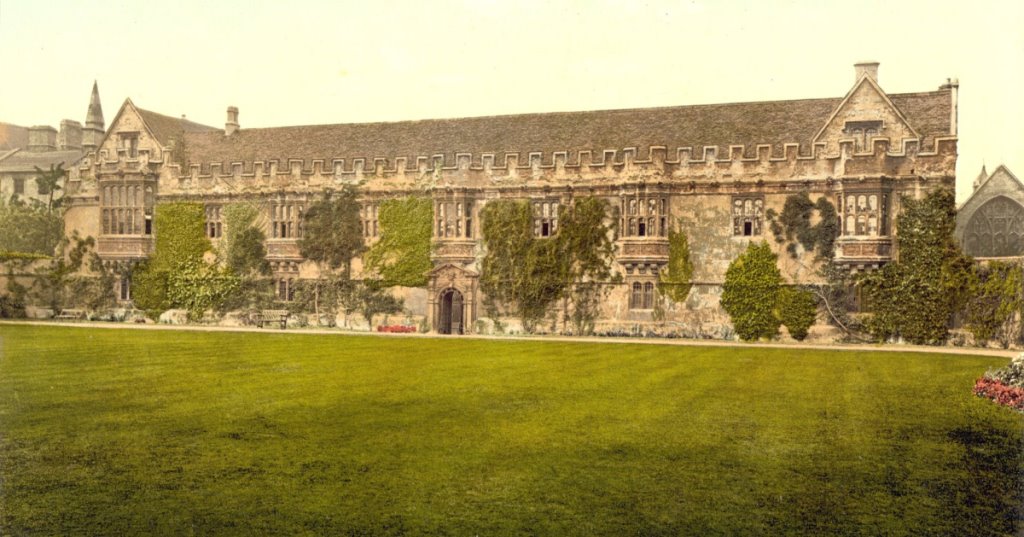
I am working on Star Chamber Elizabeth and the transcription in The Historic Society of Lancashire and Cheshire Journal was brought to my attention. It would take someone with the brains of an intelligence officer to have found any case in the chaos that was the PRO/TNA class STAC 5. If you ever find his research notes, please share them.
Helen Good
https://waalt.uh.edu/index.php/Elizabethan_Star_Chamber_Project
Thanks Helen! I’ll keep you posted if ever I find anything.
I commented on your earlier post about EB Goodacre. I was researching the Prescotts of Ayrefield at the time which led me to your post. I have since located copies of the book about the Prescotts. In the proof version he was credited as a co-author. However, when it was published his name had been removed but he was acknowledged in the preface as an important contibutor. It was published under the slightly diffent title of “The Chronicles of the Prescotts of Ayrefield”. This explains why I struggled to locate the book.
In the preface EBG is described as an eminent palaeographer. This expertise in finding, translating, and interpreting historic sources will have made him a useful recruit for the inteligence service.
Hi Jim,
Thanks so much for the comment! One mystery solved. And the tip on him being a paleographer is cool.
Thanks again,